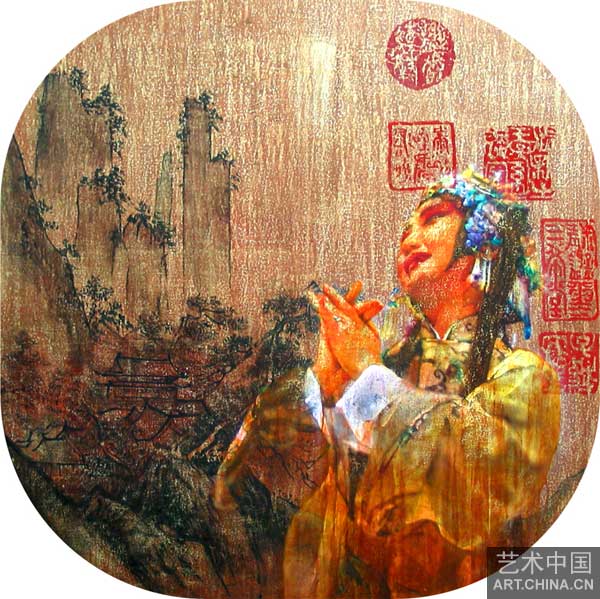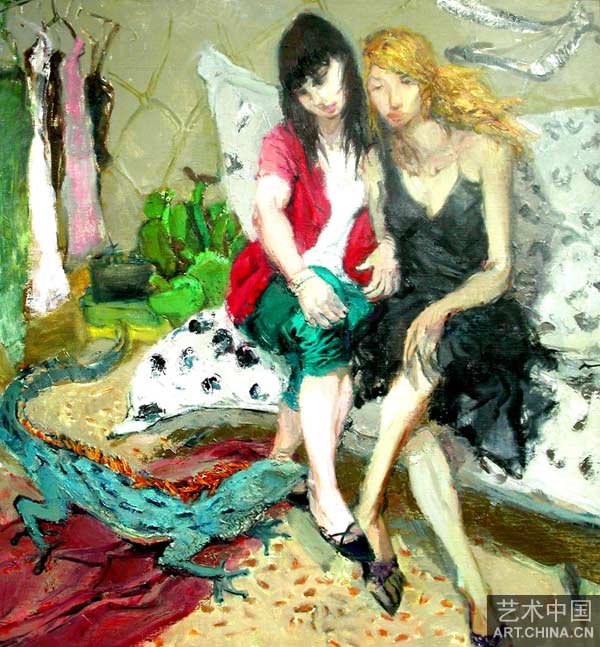|
後現(xiàn)代的迷情與幻影
80後新銳藝術(shù)系列展之三

龍藝榜畫廊
策展人:托尼
2007年3月1日至4月30日
懷疑、自我、自相矛盾是80後青年的心理特徵,在其藝術(shù)創(chuàng)作中表現(xiàn)出帶有主觀色彩的強(qiáng)烈的非理性力量。龍藝榜80後新銳藝術(shù)展之三的藝術(shù)家許碩、姜川、張姍姍等共同顯示了獨(dú)特的後現(xiàn)代複雜性,其題材和繪畫形式上在歷史與當(dāng)代、現(xiàn)實(shí)與潛意識之間恣意衝撞,閃爍出生猛而粗礫的顛覆性。
許碩迷戀于私秘化地對歷史的批判性思索和遊戲式的後現(xiàn)代主義顛覆。絢麗的粉紅色彩雲(yún)之上出嫁的七仙女半裸酮體、手持象徵少女純潔的百合,面紗後的眼神卻是現(xiàn)代女人才有的大膽與曖昧。許碩雄心勃勃的歷史寓言蘊(yùn)涵著神奇的詩意、反諷,在當(dāng)代語境下迸射出生猛的爆發(fā)力。
曾榮獲全國美術(shù)學(xué)院畢業(yè)生作品金獎的姜川在宋代山水背景上的悲情戲劇顯示出源於中央美院壁畫係的藝術(shù)家對畫面構(gòu)造、質(zhì)地肌理等繪畫性方面學(xué)院派的精緻與考究。傳統(tǒng)圖式中戲子的脂粉紅顏和秋波明眸在永恒彌堅(jiān)的山水之間朦朧動人,緊張、絢麗、刻意的聚焦不清晰、圖像化傾向與作品中戲劇化情感的極度張力相結(jié)合,貼切、恰當(dāng)?shù)仉[寓古典精神如鏡花水月般的憔悴凋零,是經(jīng)典淪落的傷情輓歌。

清純的女性藝術(shù)家張姍姍畫面卻是印象派和表現(xiàn)主義的精緻與狂野的混合,浪漫的女性生活題材于平靜中流露野性,在優(yōu)雅中暗示荒謬。女人與蜥蜴等作品中對變形的趣味、非理性的熱情暗示當(dāng)代年輕女性心理世界的多樣性與複雜性。
“所謂現(xiàn)代既是所有時(shí)代與之並存。” 此展覽的藝術(shù)傢具有多元的藝術(shù)觀念和意識形態(tài),他們以當(dāng)代映射歷史,從潛意識角度逼近現(xiàn)實(shí)。個(gè)人風(fēng)格強(qiáng)烈,卻難以界定、拒絕訴説、遊移不定,他們主觀、內(nèi)省,試圖審視內(nèi)心之井的詭秘微瀾,神秘的反光折射出在當(dāng)代全球化的社會、文化的洶湧變革面前變幻莫測的自我的影子。

Shadow and Illusion of Postmodern Fantasy
Post-80s avant-garde artists series exhibitions Phrase III
Amelie Gallery
Curator: Tony Chang
March 1st -April 30th, 2007
Self-contradiction, subjectivity are mentalities of post-80s young generation. Reflected in their art, they exercise a vigorous, irrational approach with subject matters ranging from history to presence, reality to sub-consciousness. In phrase III of Amelie Gallery’s post-80s artists’ exhibition, participating artists Xu Shuo, Jiang Chuan and Zhang ShanShan etc. demonstrate playful and disruptive postmodern fantasy.
Oil painter Xu Shuo is ambitious in his ironic adventure questioning conventional perception of Chinese tradition. Half-naked fairy lady in Chinese folktales rides on pink clouds, holding lily flowers (symbol of female innocence), hidden behind her veiling, shadiness in her eyes are as confrontational as modern women. In Xu Shuo’s privately-decoded new fairytales, outrageous poetry and absurdity interlace, bursting with raw vigor.
Golden Award Winner of 2006 National Art Academies Graduates exhibition, Jiang Chuan paints Chinese opera actress against classic landscape paintings of Song Dynasty (960-1279 A.D.). With an unfocused visual treatment, artist put actress on semi-transparent, illusional surface just like fading ancient mural paintings; the emotion is intensive, sentimental and fragile.
Female artist Zhang ShanShan demonstrates interlaced balance between impressionism and expressionism, her portrayal of intimate female existence is peaceful but bizarre, pleasant whilst striking, which echo the diversity and complexity of modern feminism.
These artists transform history through presence, distort reality with subconscious mirror, and engage themselves in self-indulgent pleasure gazing at the shadow and illusion that are subtle reflection of ideological fragmentation of modern China.
|

